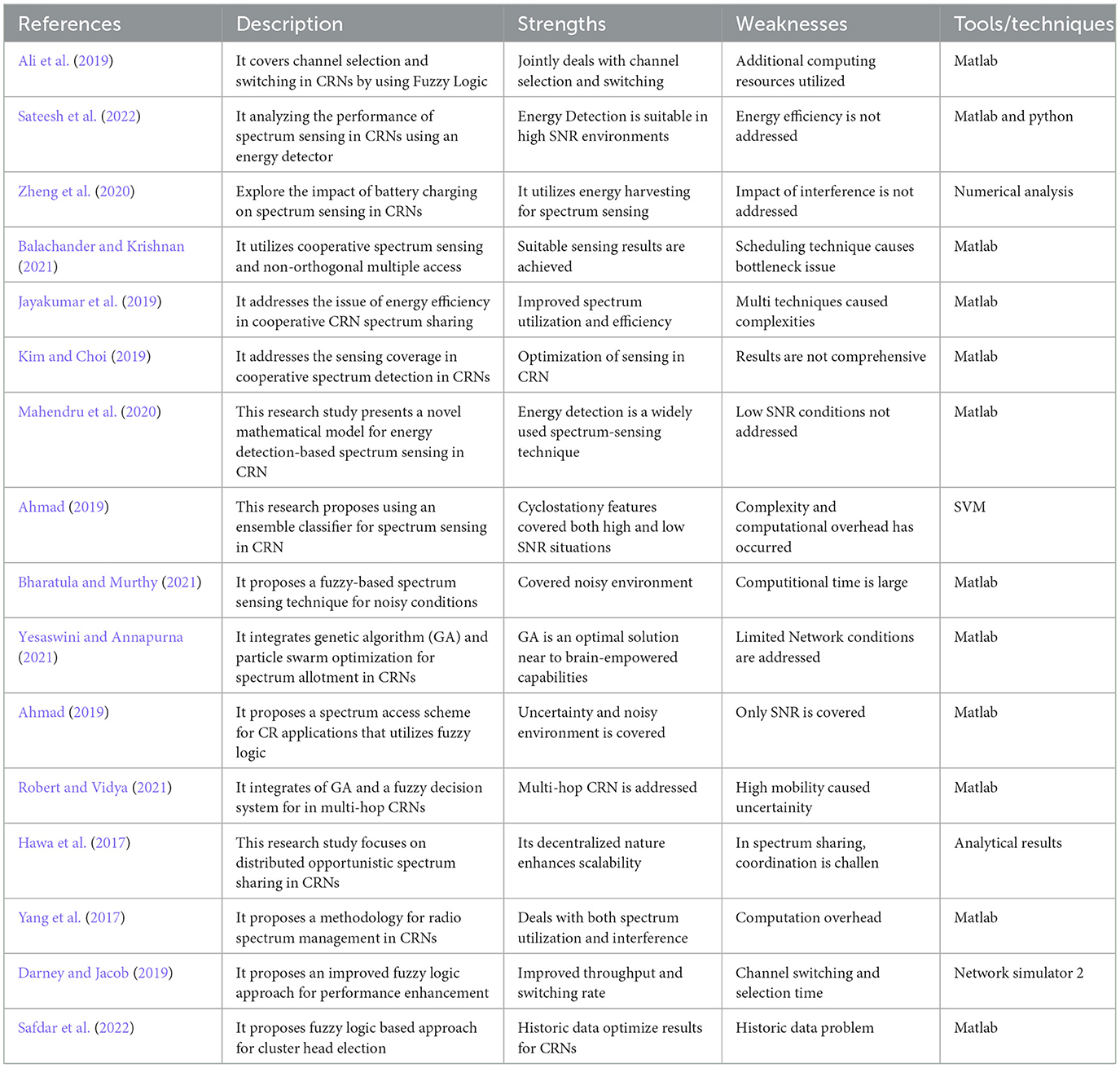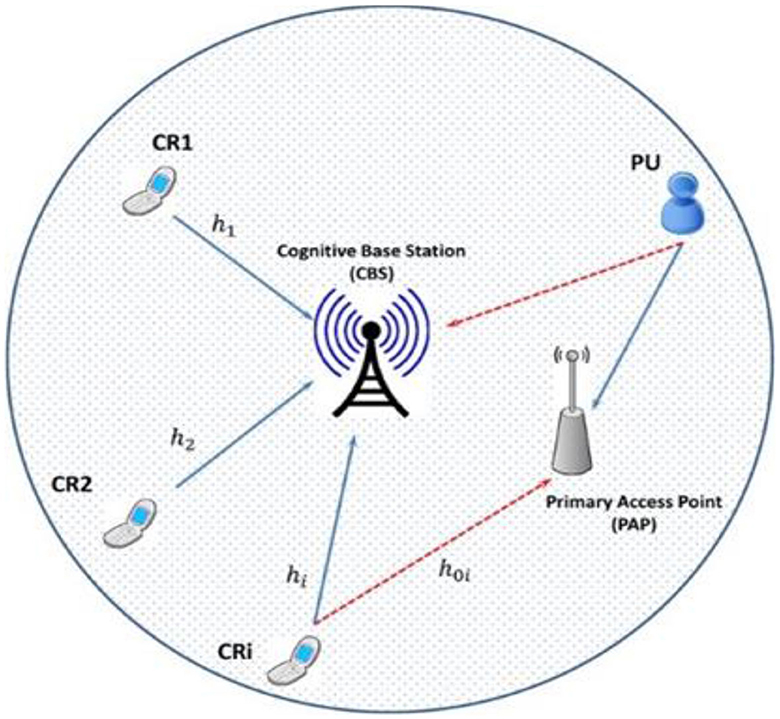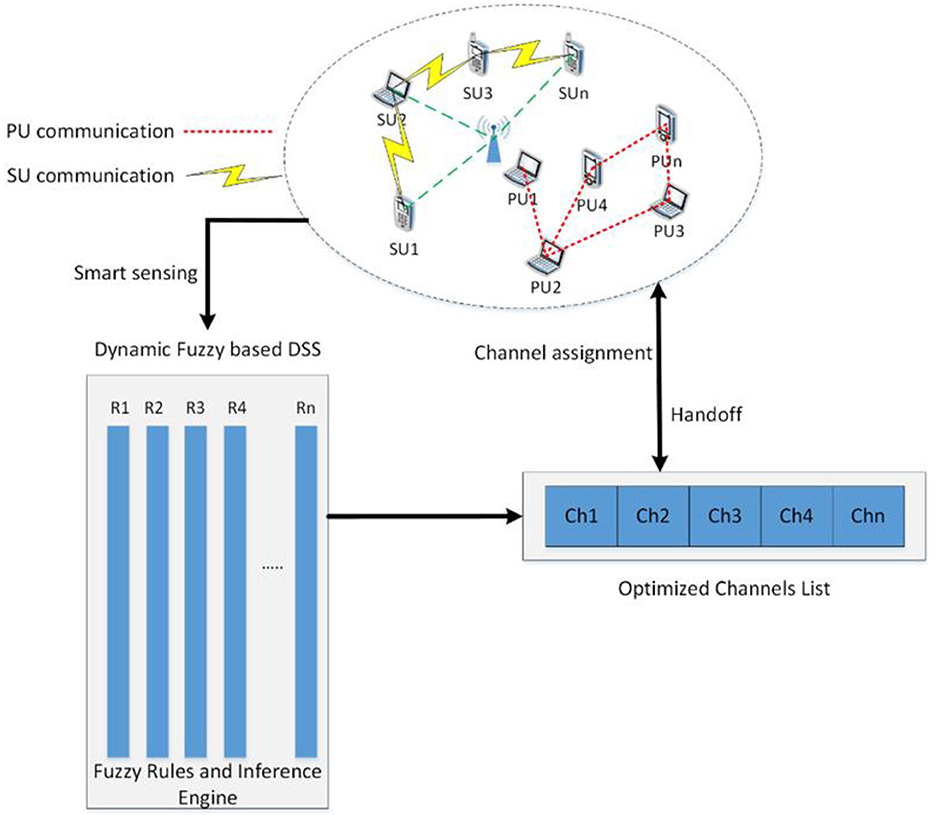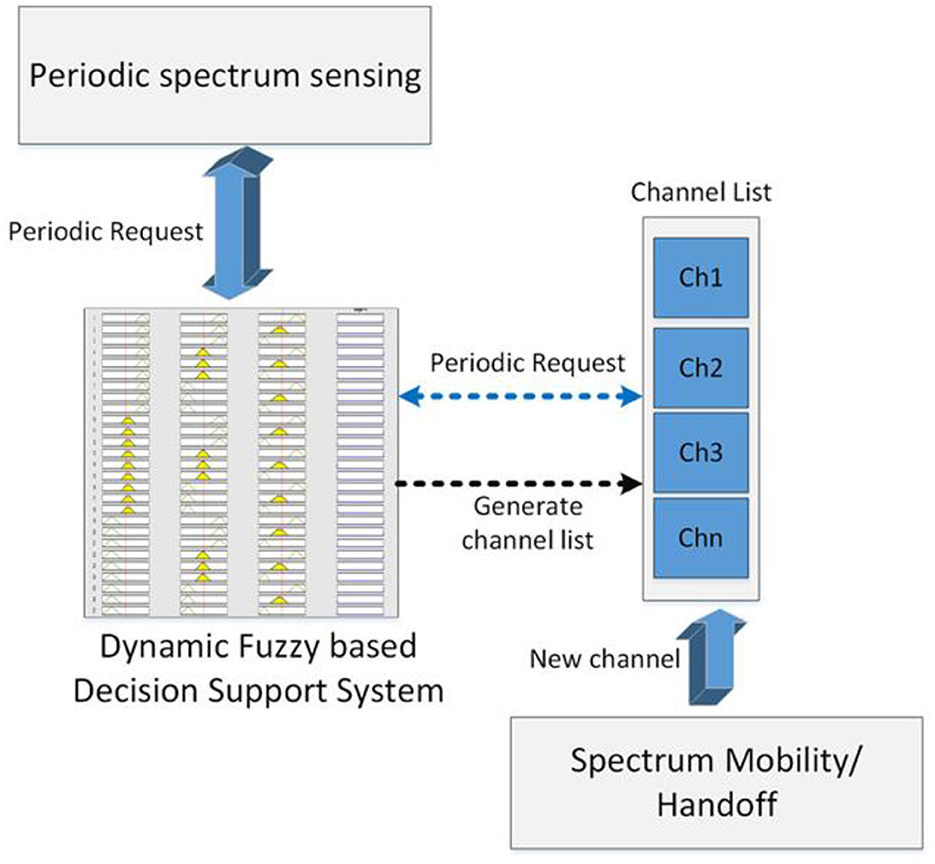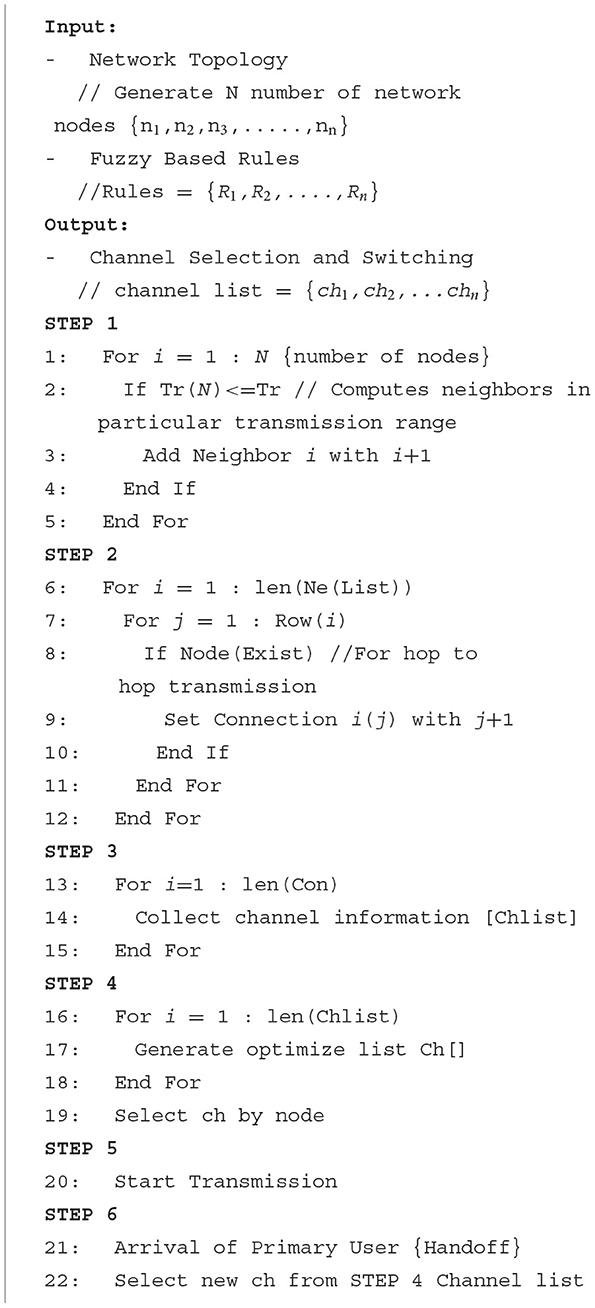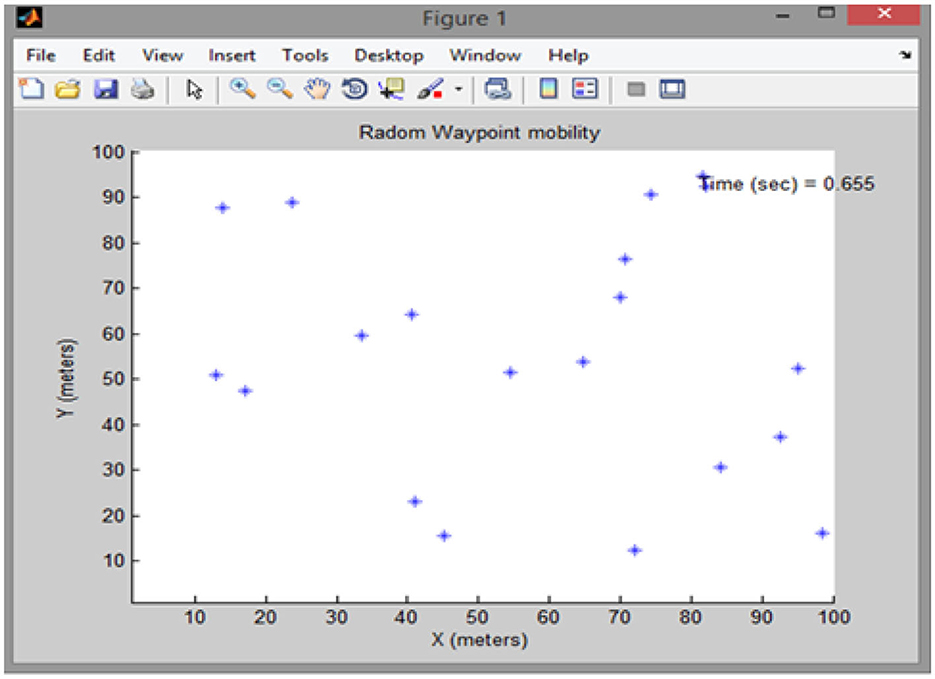Smart sensing enabled dynamic spectrum management for cognitive radio networks
- 1Department of Computer Science, University of Sialkot, Sialkot, Pakistan
- 2Department of Information Technology, Imam Mohammad Ibn Saud Islamic University, Riyadh, Saudi Arabia
- 3Knowledge Unit of Systems and Technology, University of Management and Technology, Sialkot Campus, Sialkot, Pakistan
- 4Department of Computer Science, University of Chakwal, Chakwal, Pakistan
- 5Department of Electrical and Computer Engineering, The University of North Carolina at Charlotte, Charlotte, NC, United States
Cognitive Radio Networks (CRNs) have ushered in a transformative era in wireless communication, reshaping the landscape of radio spectrum utilization and management. At the core of CRNs lies the pivotal capability to sense the radio frequency spectrum dynamically and adapt transmission parameters to preemptively address interference and optimize spectrum utilization. This article addresses the escalating challenges associated with Quality of Service (QoS) management in CRNs, exacerbated by their dynamic nature, especially in scenarios characterized by high mobility. Concurrently, the article underscores the critical significance of energy efficiency, given its direct implications on network operational costs and sustainability. To effectively navigate the intricate interplay between QoS and energy management in CRNs, we propose a Smart Sensing Enabled Dynamic Spectrum Management scheme (SSDSM). Within the SSDSM framework, cognitive user energy undergoes intelligent sensing, while QoS is governed through dynamic spectrum management. The proposed scheme optimizes service response time by refining fuzzy-based controllers and curtails energy consumption through periodic sensing triggered by predefined rules. Operationalizing within a centralized paradigm, the entire network is overseen by a central controlling node, tasked with formulating an optimal channel list using the SSDSM scheme and allocating it to cognitive users. The efficacy of the proposed scheme is evaluated and validated through rigorous testing using MATLAB. Results reveal tangible enhancements in system efficiency, encompassing maximized throughput, reduced handoff ratio, and minimized service response delay. This research contributes to the ongoing discourse on advancing the performance metrics of cognitive radio networks in the pursuit of reliable and sustainable wireless communication services.
1 Introduction
The evolution of wireless communication into its next generation underscores the imperative of embracing burgeoning network technologies to facilitate the implementation of intelligent and Autonomous Network Management (ANM), thereby optimizing resource utilization. This necessitates the deployment of network elements characterized by dynamism, flexibility, and reconfigurability to furnish a spectrum of diverse and customizable services within a heterogeneous environment, ultimately elevating the Quality of Experience (QoE) for users. Within the intricate milieu of heterogeneous mobile networks, the radio spectrum emerges as a pivotal and finite resource, subject to the random and asymmetric access of billions of devices across licensed and unlicensed spectrums. Effectively harnessing the available radio spectrum while safeguarding user-level QoS necessitates the incorporation of emerging technologies such as Cognitive Radios (CRs), which assume a pivotal role in this endeavor. The structural framework of a cognitive radio network is delineated by users endowed with cognitive radios, denoted as Secondary Users (SUs). Primary Users (PUs), possessing priority access, exclusively occupy authorized channels. CR-based SUs capitalize on the opportunity to judiciously exploit these licensed channels allocated to PUs. The fundamental tenet dictates that PUs, as primary stakeholders, retain unimpeded and exclusive rights to employ the licensed channels without disruptive interference from SUs. However, it is imperative to note that a harmonious coexistence is feasible between PUs and SUs, contingent upon the proviso that the cumulative interference generated by SUs remains below a pre-established threshold, as elucidated in the relevant literature (Bala et al., 2023).
CRNs have surfaced as an efficacious wireless paradigm, facilitating the optimized utilization of the constrained radio frequency spectrum. Secondary Users (SUs), denoted as unpaid network users, possess the capability to judiciously exploit the freely available spectrum pre-allocated to PUs without instigating deleterious interference. The foundational premise underpinning CRNs revolves around the application of sophisticated signal processing algorithms and Artificial Intelligence (AI) techniques. These technologies empower devices within the network to actively sense their surrounding environment, undertake a comprehensive analysis of the available spectrum, and subsequently make judicious decisions regarding data transmission, all while avoiding any disruptive interference to Primary Users (PUs). Within the architectural framework of CRNs, Cognitive Radio (Alqahtani et al., 2023) assumes a pivotal role in orchestrating these cognitive functionalities.
These networks are underpinned by Software Defined Radio (SDR), a technology capable of dynamically adapting to evolving conditions in the wireless environment. The parameters governing cognitive radios, such as frequency, modulation, power, and other communication characteristics, undergo dynamic adjustments contingent upon the prevailing spectrum availability and other pertinent environmental factors. The inherent capacity of CRNs to address the exigency of spectrum scarcity is particularly salient, given the escalating challenge posed by this issue in tandem with the ever-growing demand for wireless services (Paul and Choi, 2023).
Nonetheless, the implementation of CRNs encounters various challenges. A primary obstacle revolves around the imperative for proficient spectrum sensing techniques, necessitating the accurate detection of PUs while simultaneously minimizing instances of false alarms and missed detections. Another formidable challenge lies in establishing effective spectrum-sharing policies and regulations, essential for guaranteeing the equitable and efficient utilization of open spectrum resources by all users within the network. The implementation of CRNs is fraught with various technical challenges, encompassing the imperative for efficient CR architectures, advanced signal processing algorithms, and effective power management techniques. Notwithstanding these challenges, CRNs hold the promise of transforming wireless communication through their capacity to enable more resourceful and flexible utilization of the constrained available spectrum. Consequently, both academic researchers and industry practitioners are investing substantial efforts in research and development endeavors directed toward the advancement of CRNs (Xu et al., 2022; Serghini et al., 2023).
The principal objective of CRNs resides in the efficient utilization of spectrum resources. However, the inherent dynamism of the network introduces diverse challenges, encompassing issues such as network overhead, continuous sensing processes, network throughput, and transmission time. Although existing methodologies endeavor to improve the performance of spectrum usage, there exists a imperative for intelligent centralized schemes that can optimize the utilization of identified spectrum opportunities. Within CRNs, the process of making decisions regarding handoff or channel switching in response to the arrival of primary users assumes critical significance, given the often incomplete and ambiguous nature of the sensed information. In this context, relying solely on crisp logic for such decisions becomes impractical for networks empowered by cognitive radio. Moreover, the intricate interplay between channel selection and its subsequent impact on channel switching renders the realization of fully autonomous channel-switching decisions not always feasible. The endeavor to diminish the frequency of channel switching in CRNs entails the imperative selection of an optimal channel for transmission. Nevertheless, the intrinsic challenges stemming from the incompleteness and ambiguity inherent in the sensed information within CRNs compound the complexity of this decision-making process (Zheng et al., 2022).
The dynamic spectrum access capability inherent in CRNs empowers them to actively sense the spectrum and harness idle or underutilized channels, thereby enhancing the overall QoS within the network. However, amid the escalating demand for wireless communication, the issue of energy consumption has emerged as a critical concern in wireless networks. Consequently, the imperative for energy-efficient designs is paramount to ensure the sustainability of CRNs. These networks present a distinctive opportunity to strike a balance between QoS and energy consumption through the implementation of intelligent decision-making algorithms and adaptive resource allocation techniques. The allure of CRNs as a research area lies in their capacity to offer a unique platform for achieving this tradeoff, showcasing substantial potential for future developments. This paper introduces a novel approach, namely, Smart Sensing-Enabled Dynamic Spectrum Management, to address QoS dynamically within CRNs. This is achieved through the implementation of a Dynamic Fuzzy Logic-Based Decision Support System (DFDSS). Additionally, the proposed approach optimizes the energy levels of cognitive users by leveraging smart sensing mechanisms. Within CRNs, the significance of QoS is underscored by the dynamic nature of spectrum allocation. Simultaneously, energy optimization assumes paramount importance to guarantee the efficient operation of the network while minimizing the energy consumption associated with cognitive radios. Through the reduction of radio energy consumption, CRNs have the potential to prolong the battery life of mobile devices and mitigate the environmental impact of wireless communication. To strike a balance between QoS and energy optimization, this paper proposes the SSDSM scheme. The presented scheme exhibits superior throughput compared to prevailing approaches and plays a pivotal role in mitigating the channel switching rate for Secondary Users (SUs), thereby enhancing the flexibility of channel selection. Our contribution is evident in the optimization of energy for SUs through the implementation of Periodic/Smart Sensing and the concurrent improvement of QoS by diminishing the Service Response Time of the SSDSM. Simulation results affirm the efficacy of our proposed approach, surpassing existing schemes reliant on uncertain and imprecise sensing outcomes from secondary users.
The primary research contributions of our study encompass:
1. Our research substantially contributes to CRNs by effectively addressing two key challenges: the minimization of service response delay and the optimization of sensing. Primarily, we devised the DFDSS to mitigate service response delay within CRNs. Furthermore, leveraging the SSDSM, we formulate an intelligent resource allocation scheme that dynamically assigns available spectrum to SUs in accordance with their communication requirements. This approach guarantees efficient spectrum utilization, thereby diminishing the response delay for service requests and enhancing the overall QoS in the network.
2. Secondly, we address the challenge of spectrum sensing in CRNs. Traditional sensing schemes frequently encounter drawbacks such as elevated energy consumption and inefficient spectrum utilization. To surmount these limitations, we introduce a novel approach termed periodic or smart sensing, wherein the sensing frequency is intelligently adjusted based on the prevailing network conditions and the activity of primary users. Through the dynamic adaptation of the sensing interval, we attain a harmonious equilibrium between precise spectrum sensing and minimal energy consumption. This accomplishment culminates in enhanced network performance and an extended network lifetime.
The subsequent sections of this paper are structured as follows: Section 2 provides an overview of related work. Section 3delineates the system model. Section 4 expounds on fuzzy logic, elucidates our chosen parameters, and details the operations of the proposed DFDSS. Section 5 encompasses performance analysis and simulation results. Finally, the concluding section synthesizes the key findings of the paper.
2 Related work
This section briefly explores the current state-of-the-art in spectrum sensing and utilization schemes.
Ali et al. (2019) conducted a study investigating the ramifications of channel selection and switching on the overall performance of CRNs. Their contribution involved the introduction of a fuzzy logic-based channel selection scheme (FLCS), wherein multiple controllers were engaged in the selection and switching mechanism. The authors devised two distinct Fuzzy Logic controllers, each configured to take different parameters as input and apply fuzzy-based rules to them. The first controller was specifically crafted to generate an efficient channel list, from which the SU could select a channel for transmission. Nevertheless, in the event of a primary user's arrival, a handoff took place. In the scenario of a hard handoff, the second controller employed pre-calculated parameters, including channel rank, derived from the previously generated channel list, and subsequently selected the optimal channel for the ongoing transmission. To assess the efficacy of the formulated algorithm, the authors employed MATLAB. This investigation underscores the significance of channel selection and switching in CRNs while demonstrating the potential of fuzzy logic-based approaches in mitigating these challenges. In a related context, Sateesh et al. (2022) advocated the utilization of energy detection as a sensing technique in CRNs. The cognitive users engage in energy detection and transmit identified available opportunities to a central control station. This central control station, in turn, determines the channels to be utilized based on various sensing rules. Additionally, the authors expanded on the concept of Multiple Input and Multiple Output (MIMO) in the realm of channel selection, aiming to enhance the overall performance of the CRN. The validity of the proposed approach was substantiated through simulations conducted using both Python and MATLAB. The outcomes demonstrated that the proposed approach outperformed conventional channel selection methods. This study underscores the critical significance of adept sensing techniques and judicious decision-making processes for the effective implementation of CRNs.
Zheng et al. (2020) directed their attention toward the power capabilities of secondary users within CRNs and its consequential impact on network performance. Their focus lay in scrutinizing the hybrid mechanism involving overlay and underlay approaches, considering varying transmission power levels. The study delved into the implications of this hybrid approach on factors such as battery life and energy harvesting, particularly during both sensing and data transmission phases. The objective of the study was to formulate an optimal policy for spectrum sensing, with the overarching goal of maximizing the network's throughput. This optimization sought to address collision constraints while concurrently balancing energy constraints. The CRN was partitioned into three states contingent on the battery's power, consumption, and energy harvesting parameters. Within each state, secondary users undertake the decision-making process of either utilizing the available spectrum or charging the battery. The research endeavor optimized the threshold of available spectrum opportunities, with the aim of striking a balance between energy considerations and collision constraints, all while maximizing network throughput. The study's conclusions indicate that the proposed metric effectively optimizes spectrum sensing, emphasizing the substantial impact of battery charging on the overall network performance. Shifting focus, Balachander and Krishnan (2021) delved into wireless technologies employing Non-Orthogonal Multiple Access (NOMA) and its application in cooperative spectrum sensing. The authors elucidated on the augmentation of CRNs performance through the incorporation of recent advancements in NOMA. This framework empowers secondary users to exploit freely available spectrum bands. The proposed study amalgamated cooperative sensing with NOMA, leading to an enhancement in the overall performance of network spectrum sensing. Notably, the suggested technique exhibited efficiency in cooperative sensing even in the presence of channel noise. The authors expounded on the significance of uncovering spectrum opportunities, illustrating how such discoveries facilitate the effective utilization of the frequency band through shared access between primary and secondary users. The study substantiated that the proposed NOMA method surpasses existing techniques in terms of efficiency and accuracy, as corroborated by graphical representations and tabulated parameters. Consequently, it is deemed a pivotal technique in the advancement of 5G technology.
Jayakumar et al. (2019) proposed an energy-efficient spectrum sensing scheme for hierarchical clustering cooperative sensing, employing a multi-layer criteria-based decision support system. Cluster heads oversee spectrum allocation among members based on various criteria, optimizing energy efficiency and spectrum utilization. Kim and Choi (2019) highlighted issues in spectrum detection due to the rapid growth of the Internet of Things, emphasizing challenges with conventional spectrum allocation schemes. The authors elucidated that Cognitive Radio (CR) presents an optimal solution to spectrum detection challenges, but the presence of hidden primary users can lead to inaccuracies in identifying available spectrum bands. Existing machine learning-based techniques are effective when node existence is not considered. To address this, the authors proposed a strategic machine learning approach for placing sensing nodes. The findings underscore that the hidden primary user issue can impact spectrum sensing accuracy. To overcome this, they utilized Kullback-Leibler divergence, deriving an analytical expression for the spectrum sensing coverage of a single node. The presented strategy efficiently places a limited number of nodes to cover the entire area of the primary user.
Mahendru et al. (2020) proposed an optimal mathematical model with an energy detection mechanism for spectrum sensing in low SNR environments with noisy channels in CRNs. The scheme employs multiple sensing samples and analyzes the information with noise, utilizing SNR to optimize the detection probability and minimize false detection probability. The authors highlighted the significance of optimizing spectrum sensing in Cognitive Radio Networks. Ahmad (2019) outlined CRN limitations, including incomplete information about primary users, high computing power needs, low SNR conditions, and the discovery of licensed users in the network. To address these challenges, the authors suggested a machine learning-based spectrum discovery mechanism that adeptly handles spectrum sensing. This proposed scheme employs cyclostationary features and relevant classifiers to improve the performance of CRNs in low Signal-to-Noise Ratio (SNR) environments. In addition to established classifiers like support vector machines and conventional cyclostationary feature extraction, the proposed ensemble classifier demonstrated effective sensing outcomes.
Bharatula and Murthy (2021) discussed the surging demand for wireless technologies and the limited spectrum availability, positioning CRNs as a key technology. They emphasized the critical role of the primary user detection mechanism, affected by weak signals and fading, influencing CRNs' performance. To surmount these challenges, an innovative fuzzy-based spectrum sensing is proposed, aiming to address issues in conventional cooperative sensing mechanisms. This scheme leverages the sensing results of two neighboring nodes in the sensing process of any given node. Yesaswini and Annapurna (2021) outlined that the primary challenges in future wireless networks lie in the discovery of an efficient and reliable spectrum for seamless transmission. Another noteworthy concern is the underutilization of the available band, attributed to the crowded spectrum occupied by licensed users. The authors contended that cognitive radio is well-suited to efficiently utilize this freely available spectrum band. In their research, they introduced a Genetic Algorithm-based Channel Selection (GACS) algorithm to effectively allocate spectrum bands to secondary users, aiming to achieve optimal spectrum management.
Ahmed and Shaikh (2018) highlighted that CR offers an optimal solution for efficiently utilizing discovered spectrum band opportunities. They emphasized the critical role of decision-making in spectrum management, especially in the presence of ambiguous Signal-to-Noise Ratio (SNR) information. To address these challenges, this study introduced a fuzzy logic-enabled decision system designed to collectively handle uncertain cognitive environments and Signal-to-Noise Ratio (SNR), optimizing spectrum management. Robert and Vidya (2021) emphasized that tackling spectrum scarcity is a formidable challenge, and Cognitive Radios (CRs) serve as a solution. The research underscored that CRNs provide an additional bandwidth spectrum, owing to their dynamic spectrum access nature and wireless heterogeneous architectures. To address the dynamic spectrum and heterogeneity in cognitive radios, the research proposed a genetic algorithm-based fuzzy logic decision system for handling channel selection, switching, and spectrum allocation in multi-hop CRNs (Yang et al., 2017).
Hawa et al. (2017) introduced a distributed approach for opportunistic spectrum sharing in CRNs through cooperative sensing. In this approach, Secondary Users (SUs) actively monitor the spectrum for the presence of Primary Users (PUs) and relay their observations to a fusion center (FC). The FC then makes decisions regarding the availability of the spectrum for sharing. The study introduced a novel algorithm named the Distributed Opportunistic Spectrum Sharing (DOSS) algorithm. This algorithm empowers Secondary Users (SUs) to make transmission decisions based on information acquired through cooperative sensing. The DOSS algorithm aims to maximize the transmission rate for SUs while maintaining interference levels with Primary Users (PUs) below a predetermined threshold. Yang et al. (2017) introduced a novel approach to radio spectrum management in CR networks, employing a fuzzy neural methodology. The proposed approach is designed to improve spectrum utilization efficiency while minimizing interference to Primary Users (PUs). The proposed approach comprises two primary components: a fuzzy logic system and a neural network. The fuzzy logic system is responsible for modeling the uncertainty and imprecision inherent in the spectrum management problem, while the neural network learns the relationships between the input and output variables. The paper introduces a novel objective function that takes into account both spectrum utilization efficiency and interference to Primary Users (PUs). To optimize this objective function, the paper employs a hybrid algorithm that combines Genetic Algorithm (GA) and Particle Swarm Optimization (PSO).
Darney and Jacob (2019) highlighted the pressing need for an ample spectrum in heterogeneous wireless networks to meet the growing demand of mobile devices. They emphasized the necessity for optimal spectrum allocation, given the limited bandwidth available. While cognitive radios offer an efficient solution by allowing unlicensed users to access the band, this approach diminishes the performance of secondary users, who must yield the spectrum band to primary users upon their arrival. In addressing these challenges, the researchers proposed an enhanced fuzzy logic-based decision support system that simultaneously manages channel switching and selection. This proposed architecture demonstrated improvements in channel throughput and switching rates. Safdar et al. (2022) articulated that the performance of cooperative spectrum sensing in cognitive infrastructure is significantly impacted by the constraints imposed by limited power in cognitive nodes. To tackle these challenges, a proposed cluster-based approach consolidates multiple nodes into a single cluster, where a designated cluster head manages data collection and communicates with the central base station. The study introduces an energy-efficient fuzzy logic system with new parameters for cluster head selection, offering a calculated solution to address the outlined issues.
2.1 Summary of existing studies
Existing studies highlight the crucial roles of QoS and energy optimization in CRNs, utilizing spectrum sensing and dynamic spectrum allocation for efficient spectrum resource utilization. QoS ensures performance satisfaction for diverse users and applications, while energy optimization aims to minimize cognitive radio device energy consumption. By concurrently optimizing QoS and energy, CRNs can achieve enhanced resource utilization and overall network performance. However, there is a notable scarcity of research that comprehensively addresses these challenges simultaneously. The presented solution tackles these challenges by introducing Smart Sensing to improve energy efficiency and minimize network overhead. Additionally, Dynamic Spectrum Management is implemented to address QoS in CRNs. Table 1 provides a concise overview of existing studies, encompassing their strengths, weaknesses, and employed tools/techniques.
3 Proposed solution
CRNs are designed for optimal spectrum utilization, allowing unlicensed users access to licensed bands. However, their overall performance is heavily influenced by factors such as QoS and energy efficiency. QoS is crucial in CRNs as it guarantees uncompromised service quality, ensuring reliable and efficient communication for Secondary Users (SUs). Conversely, energy efficiency is of paramount significance to extend the battery lifespan of SUs and reduce overall energy consumption. Optimizing QoS and energy efficiency in CRNs poses a highly critical challenge. This endeavor requires the development of advanced resource allocation, power control, and scheduling algorithms. These algorithms are essential to provide QoS assurances to Secondary Users (SUs) while simultaneously preserving the network's energy efficiency.
3.1 Proposed system model
The Proposed System Model, illustrated in Figure 1, encompasses a Primary Network (PN) with N Primary Users (PUs) and a Secondary Network (SN) with M Secondary Users (SUs). The scheme employs a hybrid channel selection approach, integrating features from both overlay and underlay channel models. The Primary User (PU) is a privileged user with uninterrupted access to its paid transmission channel. Conversely, the SU is an opportunistic network user allowed to use the paid channel only in the absence of PU activity or when the interference generated by the SU remains below a predefined threshold. In the event that the unlicensed user generates interference surpassing the specified limit, the SU is obligated to vacate the licensed channel and seek another suitable channel for subsequent transmissions.
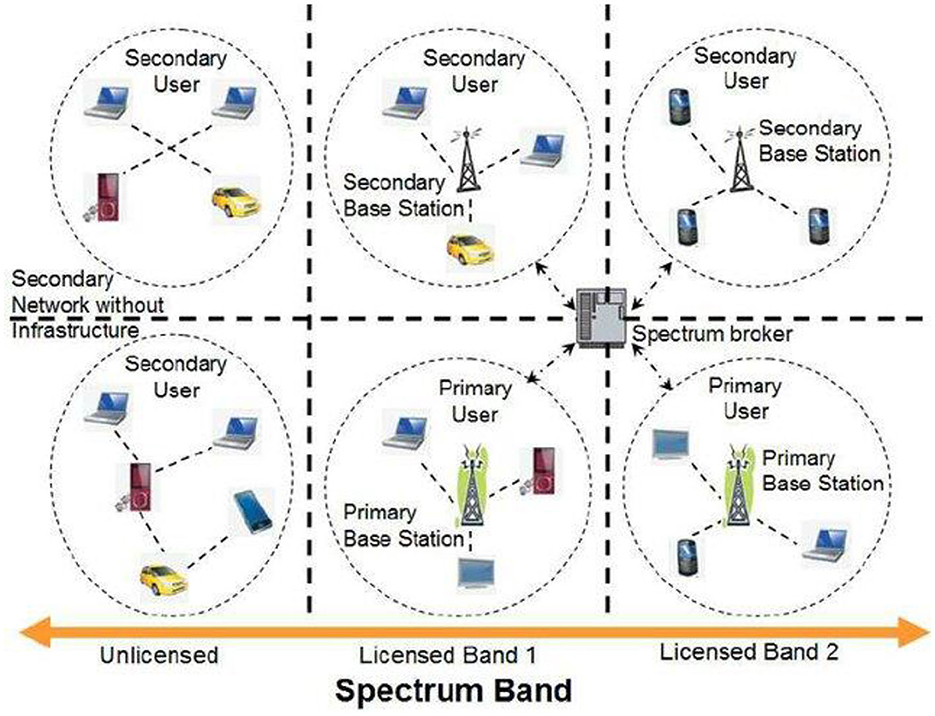
Figure 1. Proposed system model (Meghanathan, 2013).
3.2 Overview of SSDSM
This section provides a concise overview of the proposed SSDSM scheme, outlining its key phases.
3.2.1 Initialization
In CRNs, the initialization phase is a pivotal process that establishes the communication environment for the network. During this step, cognitive or secondary nodes are configured to form a network for subsequent sections, encompassing all fundamental activities.
3.2.2 Formation of centralized network
Centralized CRNs involve a central controller managing spectrum usage for multiple cognitive radios, which dynamically adjust transmission parameters to opportunistically access available spectrum bands. The controller gathers spectrum occupancy and availability data, utilizing it to allocate spectrum to the cognitive radios. Cognitive radios then interact with the central controller to receive spectrum allocation and adjust their transmission parameters accordingly. During this step, Secondary Users (SUs) organize themselves within the centralized network architecture, with a single central base station controlling and managing the entire network (Peng et al., 2021).
3.2.3 Spectrum discovery
Spectrum Sensing is pivotal in CRNs, enabling Cognitive Radio Devices (CRDs) to detect and leverage available spectrum opportunities. Through sensing, CRDs can identify spectrum bands unoccupied by Primary Users (PUs), allowing Secondary Users (SUs) to utilize them without causing harmful interference. Spectrum Sensing in CRNs poses challenges influenced by factors like fading, shadowing, and hidden terminal issues. Fading involves variations in received signal strength due to multipath propagation, while shadowing occurs when large objects obstruct the propagation path. These factors impact the reliability of sensing results, potentially resulting in false detections or missed opportunities. To address this challenge, we adopt periodic sensing, where sensing is executed only when the channel list is either empty or approaches the pre-defined threshold limit. The sensing scheme described in Ehiagwina et al. (2022) ensures sensing is triggered only when the list containing sensing information meets pre-defined criteria, a concept applied in the SSDSM scheme.
3.2.4 Spectrum decision and mobility
CRNs leverage Dynamic Spectrum Access (DSA) technology, enabling unlicensed users to share frequency bands with licensed users. Spectrum mobility, a critical concept in CRNs, pertains to the dynamic ability of cognitive radio nodes to switch between different frequency bands, enhancing network performance. Decision-making algorithms are critical for optimal frequency band selection and switching in CRNs, essential due to the dynamic wireless environment where band availability varies over time and space, influenced by interference from other devices. Hence, cognitive radio nodes need the capability to identify and choose the most suitable frequency band for transmission to ensure optimal network performance. To address these challenges, we employed a Dynamic Decision System based on intelligent fuzzy rules (Zheng et al., 2020). Unlike SSDSM, which uses a single fuzzy controller, our approach employs two controllers: FLC1 minimizes channel switching and adjusts SU transmission power, while FLC2 operates when the SU must select a new channel for seamless transmission. However, this dual-controller approach may introduce delays in service response time, especially during spectrum mobility-induced channel switching.
3.2.5 Transmission
The SUs, organized in a centralized network, initiate transmission after receiving channel information from the base station. This process follows a hybrid approach, utilizing the interweave model until the arrival of the primary user. Subsequently, the transmission switches to an underlay model, allowing SUs to maintain transmission until interference with the primary user occurs.
3.3 SSDSM system architecture
This section delineates the system architecture of SSDSM, encompassing the SSDSM Network, architecture, framework, and the proposed algorithm.
3.3.1 SSDSM network
In this study, a centralized network model was employed, where the central base station oversees all network activities, as depicted in Figure 2. A centralized cognitive radio network operates with a central entity, termed the cognitive controller, overseeing and coordinating the utilization of Radio Frequency (RF) spectrum among the network's devices, known as secondary users. The cognitive controller maintains constant surveillance over the RF spectrum to identify unoccupied frequency bands, referred to as white spaces. Subsequently, these white spaces are allocated to secondary users for transmission. This centralized strategy imparts a heightened level of control over spectrum utilization, leading to enhanced efficiency and minimized interference with other spectrum users.
Centralized CRNs offer several advantages:
a. The central controller's access to the entire spectrum enables effective decision-making regarding frequency band usage and dynamic switching. It can prioritize spectrum allocation for high-priority applications, optimizing overall spectrum utilization.
b. The central controller can actively monitor the entire network for interference. It has the capability to take corrective measures, such as adjusting transmission power or frequency assignments, to mitigate interference issues.
c. Having a comprehensive view of the network, the central controller can optimize network performance by balancing node loads and adjusting network topology to enhance connectivity.
d. The central controller is empowered to implement security protocols, detect potential security breaches, and collaborate with nodes to identify and counteract security threats, contributing to a more secure network environment.
e. With the central controller managing the network, users can focus on their applications rather than intricate network management tasks, streamlining the user experience.
3.3.2 SSDSM architecture
SSDSM is designed to address CRN challenges, focusing on SU energy levels and network QoS. Comprising Sensing Environment, Decision Support System, and Channel List Generation, SSDSM initiates operations with smart sensing, triggered by a predefined channel threshold. The periodic sensing mechanism minimizes SU power consumption compared to continuous environmental sensing. Following sensing, the DFDSS applies predefined fuzzy rules to the sensed data. Upon DFDSS execution, an optimal channel list is generated. SUs leverage the generated list for initial transmission or hard handoff, maintaining consistency with the previous Fuzzy logic-based scheme during the handoff process. As a result, the SSDSM scheme exhibits a decrease in service response time, contributing to an improved overall QoS in CRNs, as depicted in Figure 3. Furthermore, the preference for SSDSM over GACS is driven by its targeted approach to tackle critical challenges in Cognitive Radio Networks, specifically in alleviating SU energy consumption and enhancing QoS. The distinctive integration of periodic sensing, fuzzy logic-based decision support, and optimized channel list generation in SSDSM establishes it as a customized solution for the identified issues, thereby substantiating its selection over GACS for the intended applications in CRNs.
3.3.3 SSDSM framework
Figure 4 illustrates the workflow of the proposed SSDSM, depicting the process from sensing to transmission. The operational sequence of SSDSM initiates with intelligent spectrum sensing, followed by spectrum decision-making based on the obtained sensing data. Additionally, channel switching is executed when spectrum mobility is necessitated. In SSDSM, environmental scanning occurs periodically, where scanning is triggered only when specific pre-defined criteria are met. Subsequently, the sensed information undergoes processing in the spectrum decision segment. Our devised DFDSS operates in this phase, tasked with determining the most advantageous cognitive resources for the secondary users in the cognitive or secondary network. In this stage, the DFDSS produces an optimal channel list guided by the predefined rules. Given the high mobility inherent in the cognitive environment, when confronted with mobility or the presence of a primary user, a new channel is selected from the pre-established optimal channel list. The practical effectiveness of centralized control in SSDSM is contingent on contextual fluctuations, acknowledging the adaptable nature of centralized control within the SSDSM framework.
3.3.4 SSDSM algorithm
3.3.5 SSDSM algorithm explanation
The Algorithm 1, outlined in Section 3.3.4, comprises six steps. First, in step 1, neigbor computation is executed to establish the network topology within the transmission range. Subsequently, in step 2, connections between nodes are established to facilitate hop-to-hop communications. Once the network is configured, step 3 initiates sensing by SUs to collect channel information for transmission. Following this, in step 4, the proposed DFDSS is applied to the channel information, generating an optimal channel list. SUs then choose a suitable channel from this list for transmission in step 5. Lastly, step 6 involves channel switching upon the arrival of a PU.
3.3.6 Complexity of SSDSM
The SSDSM Algorithm undergoes analysis based on the count of executed instructions. The algorithm, segmented into five steps for clarity, comprises loops and statements. The worst-case complexity of the proposed SSDSM Algorithm is determined to be O(n2), calculated by considering the execution frequency of each statement in the algorithm.
4 Performance evaluation and results
We evaluated the overall performance of SSDSM compared to the Fuzzy Logic-based channel selection schemes FLCS and GACS using MATLAB. The choice of FLCS and GACS as comparative algorithms stems from their relevance in addressing critical challenges in CRNs. FLCS and GACS represent established methodologies, each with distinct approaches to optimizing CRNs. Highlighted in the paper, FLCS integrates periodic sensing, fuzzy logic-based decision support, and optimized channel list generation within the proposed SSDSM scheme, addressing specific challenges such as SU energy consumption and QoS enhancement. FLCS's selection for comparison signifies its customized approach tailored to identified CRN issues, particularly in mitigating energy consumption and improving QoS. GACS functions as an optimization and problem-solving method within CRNs. Its primary function is to find optimal or near-optimal solutions for complex CRN problems related to resource allocation, spectrum management, routing, and other optimization tasks. Both FLCS and GACS were chosen for comparison with the SSDSM scheme due to their relevance in addressing optimization challenges within CRNs, albeit through distinct methodologies. The experimental assessments compare SSDSM with FLCS and GACS, focusing on parameters such as the number of hard handoffs, system throughput, and transmission delay.
4.1 Transmission delay
Transmission delay, in communication systems like CRNs, is the time it takes for data to travel from sender to receiver, a crucial factor affecting network performance.
4.2 Throughput
Throughput, in the context of communication systems, specifically CRNs, denotes the volume of data transmitted through a network or communication channel within a specified time frame. This metric, often measured in bits per second (bps), serves as a vital indicator of system performance. The calculation for network throughput involves determining the quantity of data successfully transferred during a given time period.
4.3 Hard Handoff
It involves promptly relinquishing the licensed channel upon the Primary User's (PU) arrival and subsequently transitioning to an alternative available licensed channel.
4.4 SSDSM topology
The network topology includes x secondary nodes (SUs) distributed across the designated network area. In SSDSM, actions are triggered upon the arrival of a Primary User (PU), and all nodes, denoted as SUs, are mobile and self-configured, moving at a speed of S over a time period T. Figure 5 illustrates cognitive users (SUs) represented by asterisks coexisting with Primary Users (PUs) in the network. Our emphasis lies in exploring SU communication and channel utilization in the presence of Primary Users (PUs). The simulation incorporates the number of SUs as a variable input to enhance network scalability. The Random Way Point Mobility model is employed to implement our system model.
4.5 Simulation results by varying transmission time
Figures 6A–C depict the performance analysis of the SSDSM scheme in comparison to FLCS (Ali et al., 2019) and GACS (Yesaswini and Annapurna, 2021) concerning hard handoff ratio, transmission delay, and network throughput. The analysis is conducted for varying simulation transmission times. Figure 6A showcases the handoff count with fixed SUs, licensed channels, and variable transmission times (20, 40, 60, 80, 100). In Figure 6B, SSDSM exhibits fewer handoffs during transmission compared to FLCS and GACS, which suffer from significant delays due to handoff management. Prolonged handoff times can significantly affect CRN performance. FLCS and GACS encounter increased switching rates as they rely on a secondary controller for selecting licensed channels for SU transmission. SSDSM, with its lower handoff ratio, operates efficiently in less time, thereby maximizing CRN performance.
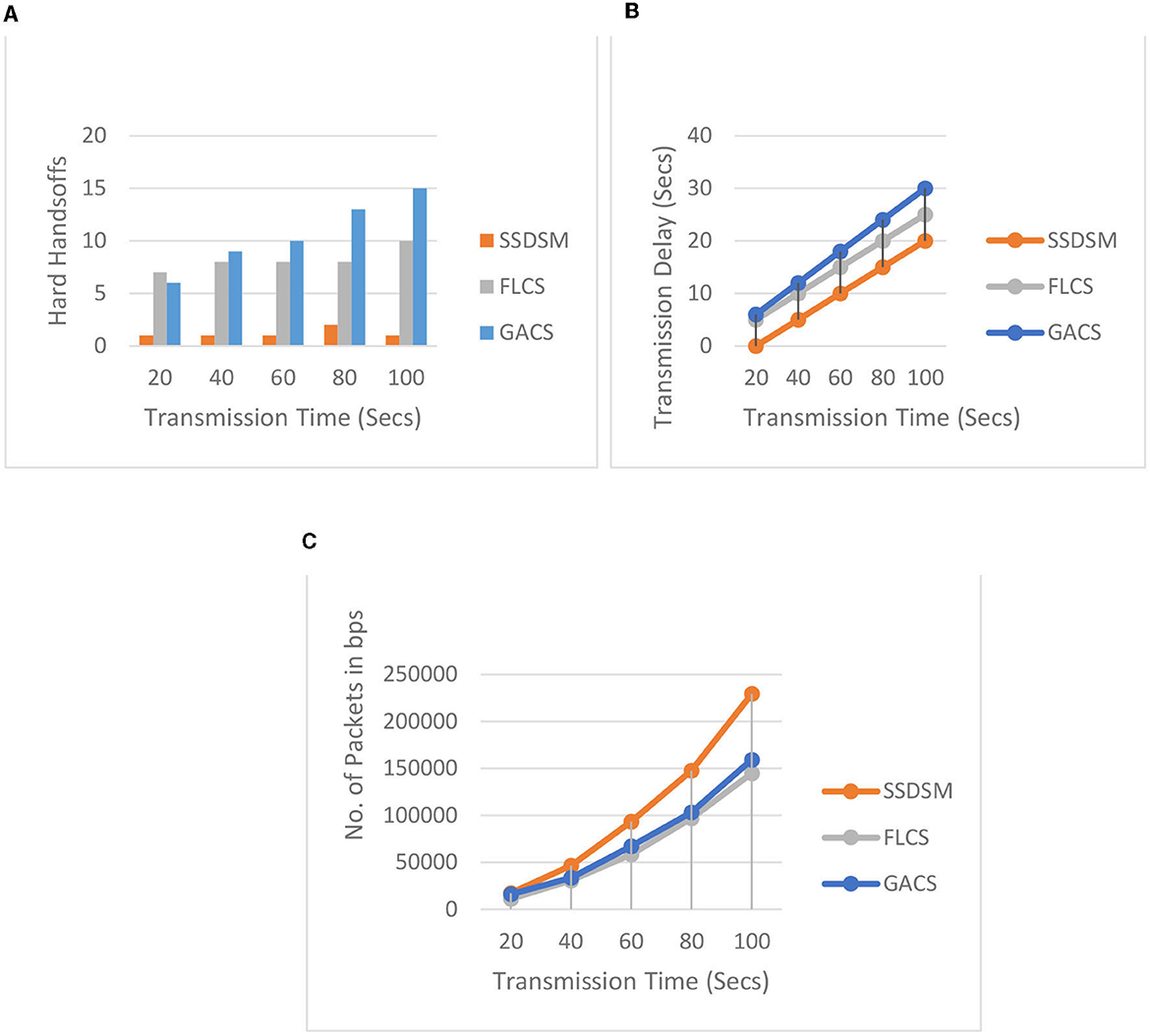
Figure 6. Simulation results by varying transmission time. (A) Hard Handoff ratio. (B) Transmission delay. (C) Network throughput.
In Figure 6B, the performance assessment of SSDSM is juxtaposed with the conventional methodologies, FLCS and GACS, concerning transmission delay, employing the pre-established simulation parameters. The findings demonstrate that SSDSM manifests reduced delays in transmissions and associated network operations compared to both schemes. This implies that SSDSM adeptly executes its dynamic fuzzy-based decision support system with enhanced efficiency. Figure 6C elucidates the performance assessment of SSDSM, emphasizing the principal objective of CRNs, namely the network's throughput. As highlighted in Figures 6A, B, SSDSM outperforms FLCS and GACS in terms of minimizing handoffs and transmission delays, positively impacting the network's throughput. The outcomes affirm that SSDSM optimizes the throughput ratio of the network within the identical simulation conditions as delineated in prior sections.
4.6 Simulation results by varying number of secondary users
Figures 7A–C depict the performance assessment of SSDSM in comparison to FLCS and GACS across varying SU quantities, spanning from 10 to 50 SUs. Throughout these experiments, licensed channels and transmission duration remained consistent. The dynamic nature of CRNs, characterized by high mobility, emphasizes the significance of network scalability in algorithmic performance. Consequently, algorithmic and system designs must account for this challenging factor. In practical scenarios, the size of CRNs fluctuates due to the continuous mobility of nodes within the wireless environment. Figure 7A illustrates the simulation outcomes of SSDSM concerning the switching ratio of SUs across licensed channels, considering various network sizes, in comparison to FLCS and GACS. The findings reveal the efficiency of the proposed SSDSM scheme, showcasing reduced handoffs across different network scales, ultimately enhancing network performance over licensed channels. Figure 7B depicts the performance assessment of SSDSM in comparison to FLCS and GACS, focusing on transmission delay within the network and communication between source and destination. As elucidated earlier, the switching channel ratios are higher in FLCS and GACS than in SSDSM. Consequently, FLCS and GACS require more time for ongoing transmissions. The outcomes indicate that the SSDSM scheme demonstrates reduced delay in completing transmissions. Figure 7C illustrates the simulation assessment of SSDSM compared to FLCS and GACS concerning network throughput. As an extension of Figures 7A, B, FLCS and GACS encountered higher switching ratios and transmission delays compared to SSDSM, resulting in a decline in network throughput. The proposed SSDSM scheme maximizes the network throughput ratio.
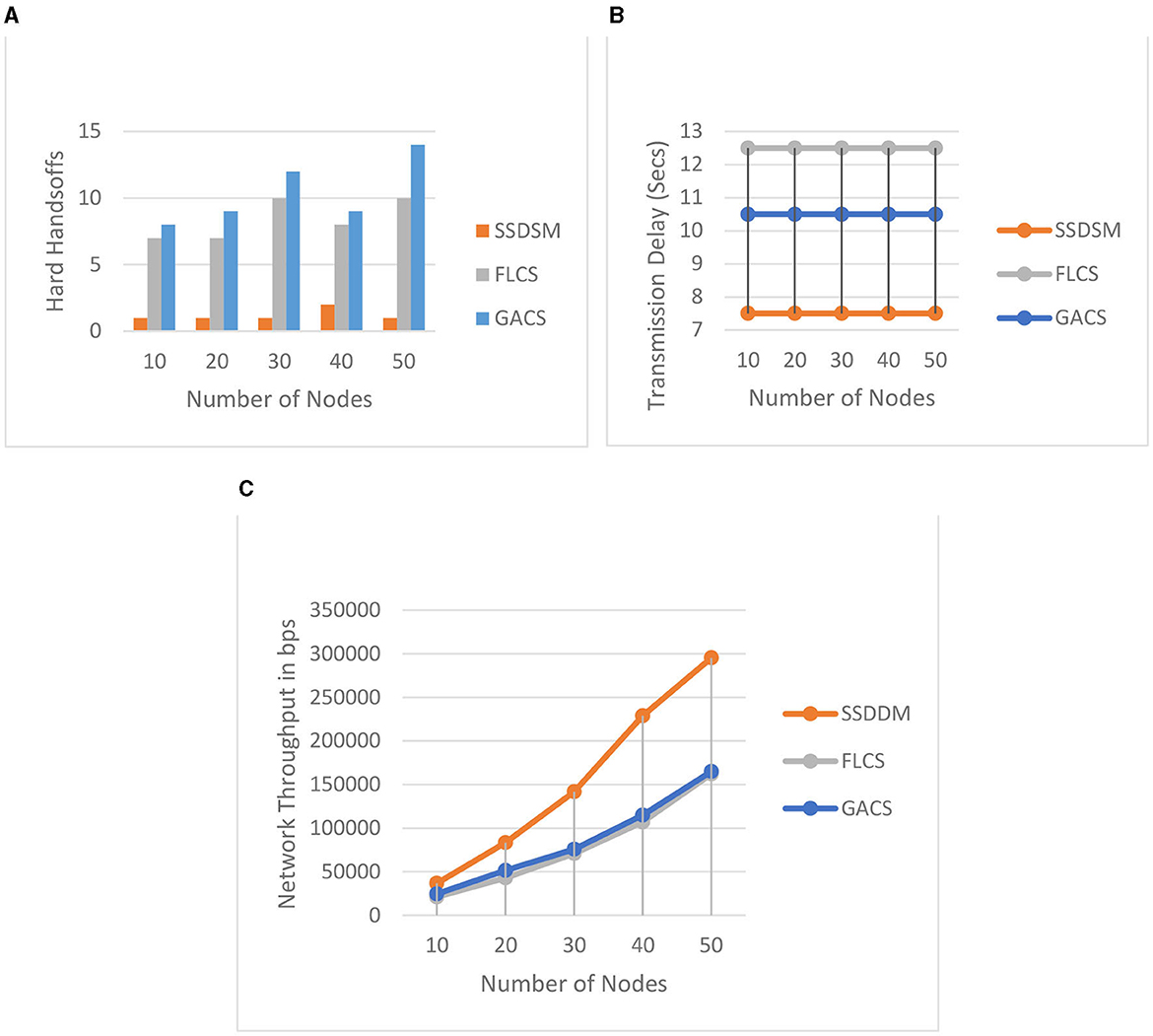
Figure 7. Simulation results by varying number of secondary users. (A) Handoff ratio. (B) Transmission delay. (C) Network throughput.
4.7 Simulation results by varying number of transmission channels
Figures 8A–C depict the performance assessment of the SSDSM scheme in comparison to FLCS and GACS, considering a varying number of licensed channels. Network size and transmission time are held constant, highlighting the pivotal role of licensed spectrum channels in CRNs, where the system's operation relies on primary users' licensed channels. Cognitive users engage in spectrum sensing to identify available segments for transmission. Smooth and reliable transmissions necessitate a thorough understanding of channel capacity and information. Therefore, any algorithm proposed should meet these prerequisites. In Figure 8A, the number of handoffs for all three schemes is observed concerning the fluctuating number of licensed channels. The findings indicate that as the number of licensed channels rises, the switching rate between channels increases, resulting in more handoffs for all three schemes.
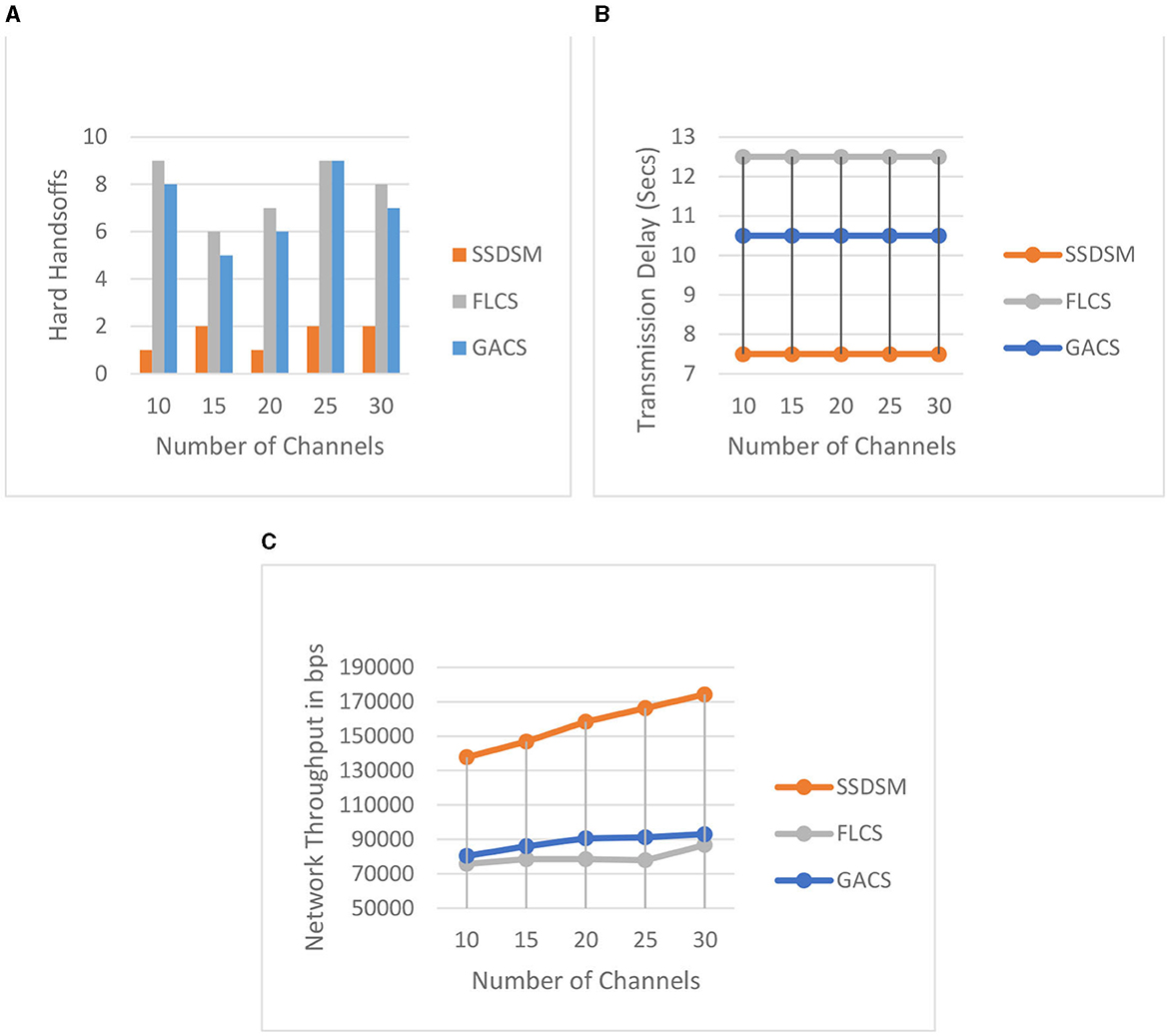
Figure 8. Simulation results by varying number of transmission channels. (A) Handoff ratio. (B) Transmission delay. (C) Network throughput.
Nevertheless, the SSDSM scheme consistently surpasses FLCS and GACS in terms of the number of handoffs, even with the escalation in licensed channels. Figure 8B illustrates the assessment of SSDSM concerning the delay in completing ongoing transmissions, juxtaposed with FLCS and GACS. As discussed earlier, frequent channel switching in FLCS and GACS results in time consumption for selecting new channels during transmission. Given this challenging aspect, our proposed SSDSM scheme demonstrates superior outcomes, exhibiting reduced delays compared to the aforementioned schemes. The results in Figure 8C signify that the SSDSM scheme outperforms both FLCS and GACS in optimizing the network's throughput, even amid variations in the number of licensed channels. This suggests that the SSDSM scheme adeptly addresses the challenges posed by the dynamic and fluctuating number of licensed channels in CRNs, thereby enhancing the overall network performance.
5 Discussion
The evaluation results of SSDSM reveal a comparatively reduced switching rate of SUs compared to FLCS and GACS, indicating that SSDSM mitigates interference to the PUs and consequently enhances the performance of CRNs. In the subsequent section, we delve into the discussion of QoS and energy optimization.
5.1 Energy optimization
CRNs represent a promising technology for enhancing spectrum utilization in wireless networks. In these networks, Secondary Users (SUs) can opportunistically access spectrum bands that are not in use by Primary Users (PUs) without causing harmful interference. The dynamic allocation of available spectrum is a key feature of CRNs, contributing to improved spectrum utilization. Additionally, energy optimization is vital in CRNs to maximize the lifespan of wireless sensor nodes and ensure the reliability of communication links. Energy optimization in CRNs encompasses diverse techniques aimed at minimizing energy consumption while preserving effective communication performance. In the proposed SSDSM scheme, we implement a smart sensing technique, conducting spectrum sensing exclusively when the pre-defined threshold limit of the channel list is reached. This approach not only conserves the energy of secondary users but also enhances the lifespan of cognitive nodes, contributing to an overall improvement in the performance of the cognitive radio network.
5.2 Quality of service
It is a pivotal element that guarantees the effective utilization of available resources, ensuring satisfactory service delivery to users. CR represents an intelligent wireless communication technology that optimizes spectral efficiency for Secondary Users (SUs) by opportunistically accessing the unused frequency spectrum originally licensed to Primary Users (PUs). QoS in CRNs is a multifaceted challenge influenced by spectrum sensing, spectrum allocation, spectrum mobility, interference management, and service response time. Addressing these challenges, SSDSM enhances various aspects, including network throughput, transmission delay, and handoff ratio, thereby achieving improved QoS in CRNs.
6 Conclusion
CRNs represent wireless communication systems that leverage advanced cognitive capabilities to optimize the utilization of radio spectrum. Specifically engineered to address spectrum scarcity, CRNs enable unlicensed users (SUs) to opportunistically access underutilized or temporarily vacant licensed spectrum bands without causing harmful interference to the primary users (PUs), who are the licensed users of the spectrum. Optimizing the performance of CRNs involves crucial considerations, notably focused on QoS and energy efficiency. CRNs are intelligently designed to dynamically allocate available spectrum to unlicensed secondary users, ensuring optimal utilization while minimizing interference with licensed primary users. The effective management of QoS and energy efficiency is pivotal for enhancing the overall performance of CRNs. To address the challenges in CRNs, we propose the SSDSM scheme. SSDSM enhances energy efficiency through smart sensing, where sensing is performed only when predefined criteria are met, and improves QoS by reducing network service response time. The scheme aims to extend the lifespan of cognitive nodes by enhancing energy efficiency and ensuring a certain level of QoS for SU transmissions. Simulations and evaluations demonstrate that our dynamic fuzzy-based decision support system in SSDSM outperforms previous schemes reliant on uncertain sensing results, providing more effective results in enhancing throughput in brain-empowered CRNs.
Data availability statement
The original contributions presented in the study are included in the article/supplementary material, further inquiries can be directed to the corresponding author.
Author contributions
MF: Conceptualization, Methodology, Writing – original draft. MM: Funding acquisition, Resources, Software, Supervision, Writing – review & editing. MH: Conceptualization, Data curation, Project administration, Writing – review & editing. RA: Conceptualization, Methodology, Validation, Writing – review & editing. JX: Data curation, Funding acquisition, Investigation, Project administration, Resources, Writing – review & editing.
Funding
The authors extend their appreciation to the Deanship of Scientific Research at Imam Mohammad Ibn Saud Islamic University (IMSIU) for funding and supporting this work through Research Partnership Program no. RP-21-07-05.
Conflict of interest
The authors declare that the research was conducted in the absence of any commercial or financial relationships that could be construed as a potential conflict of interest.
Publisher's note
All claims expressed in this article are solely those of the authors and do not necessarily represent those of their affiliated organizations, or those of the publisher, the editors and the reviewers. Any product that may be evaluated in this article, or claim that may be made by its manufacturer, is not guaranteed or endorsed by the publisher.
References
Ahmad, H. B. (2019). Ensemble classifier based spectrum sensing in cognitive radio networks. Wirel. Commun. Mob. Comput. 2019, 1–16. doi: 10.1155/2019/9250562
Ahmed, S., and Shaikh, A. Z. (2018). “Fuzzy logic enabled spectrum access scheme for cognitive radio applications,” in 2nd International Conference on Innovation in Computer Science and Software Engineering (Karachi: NED University of Engineering and Technology).
Ali, A., Abbas, L., Shafiq, M., Bashir, A. K., Afzal, M. K., Liaqat, H. B., et al. (2019). Hybrid fuzzy logic scheme for efficient channel utilization in cognitive radio networks. IEEE Access 7, 24463–24476. doi: 10.1109/ACCESS.2019.2900233
Alqahtani, A. S., Changalasetty, S. B., Parthasarathy, P., Thota, L. S., and Mubarakali, A. (2023). Effective spectrum sensing using cognitive radios in 5G and wireless body area networks. Electr. Comput. Eng. 105, 108493. doi: 10.1016/j.compeleceng.2022.108493
Bala, I., Ahuja, K., Arora, K., and Mandal, D. (2023). “A comprehensive survey on heterogeneous cognitive radio networks,” in Comprehensive Guide to Heterogeneous Networks, eds K. Ahuja, A. Nayyar, and K. Sharma (Amsterdam: Elsevier Science), 149–178. doi: 10.1016/B978-0-323-90527-5.00010-1
Balachander, T., and Krishnan, M. M. (2021). Efficient utilization of cooperative spectrum sensing (CSS) in cognitive radio network (CRN) using non-orthogonal multiple access (NOMA). Wirel. Pers. Commun. 127, 2189–2210. doi: 10.1007/s11277-021-08776-7
Bharatula, S., and Murthy, B. S. (2021). “Innovative fuzzy-based spectrum sensing technique for noisy conditions,” in Advances in Electrical and Computer Technologies, Vol. 711, eds T. Sengodan, M. Murugappan, and Misra (Singapore: Springer), 735–750. doi: 10.1007/978-981-15-9019-1_64
Darney, P. E., and Jacob, I. J. (2019). Performance enhancements of cognitive radio networks using the improved fuzzy logic. J. Soft. Comput. Paradigm 1, 57–68. doi: 10.36548/jscp.2019.2.001
Ehiagwina, F. O., Surajudeen-Bakinde, N. T., Afolabi, A. S., and Usman, A. M. (2022). A hybrid spectrum opportunities extraction scheme for cognitive wireless communication. Telemat. Inform. Rep. 7, 100014. doi: 10.1016/j.teler.2022.100014
Hawa, M., AlAmmouri, A., Alhiary, A., and Alhamad, N. (2017). Distributed opportunistic spectrum sharing in cognitive radio networks. Int. J. Commun. Syst. 30, 3147. doi: 10.1002/dac.3147
Jayakumar, L., Janakiraman, S., Dumka, A., and Paul, P. V. (2019). Energy efficient cooperative CRN spectrum sharing using multi-level hierarchical clustering with MCDM. Int. J. Commun. Netw. Distrib. Syst. 22, 196–244. doi: 10.1504/IJCNDS.2019.097655
Kim, J., and Choi, J. P. (2019). Sensing coverage-based cooperative spectrum detection in cognitive radio networks. IEEE Sens. J. 19, 5325–5332. doi: 10.1109/JSEN.2019.2903408
Mahendru, G., Shukla, A., and Banerjee, P. (2020). A novel mathematical model for energy detection based spectrum sensing in cognitive radio networks. Wirel. Pers. Commun. 110, 1237–1249. doi: 10.1007/s11277-019-06783-3
Meghanathan, N. (2013). A survey on the communication protocols and security in cognitive radio networks. Int. J. Commun. Netw. Inf. Secur. 5, 19. doi: 10.17762/ijcnis.v5i1.249
Paul, A., and Choi, K. (2023). Joint spectrum sensing and D2D communications in Cognitive Radio Networks using clustering and deep learning strategies under SSDF attacks. Ad Hoc Netw. 143, 103116. doi: 10.1016/j.adhoc.2023.103116
Peng, Y., Shao, W., Lu, C., Li, S., Wang, G., Hu, P., et al. (2021). “Spectrum Handoff based on bilateral auction mechanism in centralized cognitive radio networks,” in 2021 The 10th International Conference on Networks, Communication and Computing (New York, NY: ACM), 103–107. doi: 10.1145/3510513.3510530
Robert, V., and Vidya, K. (2021). Genetic algorithm optimized fuzzy decision system for efficient data transmission with deafness avoidance in multihop cognitive radio networks. J. Ambient Intell. Humaniz. Comput. 14, 959–972. doi: 10.1007/s12652-021-03349-9
Safdar, G. A., Syed, T. S., and Ur-Rehman, M. (2022). Fuzzy logic-based cluster head election-led energy efficiency in history-assisted cognitive radio networks. IEEE Sens. J. 22, 22117–22126. doi: 10.1109/JSEN.2022.3212267
Sateesh, C., Janardhana Gupta, K., Jayanth, G., Sireesha, C., Dinesh, K., Ramesh Chandra, K., et al. (2022). “Performance analysis of spectrum sensing in CRN using an energy detector,” in Innovative Data Communication Technologies and Application, Vol. 96, eds J. S. Raj, K. Kamel, and P. Lafata (Singapore: Springer), (pp. 447-459). doi: 10.1007/978-981-16-7167-8_32
Serghini, O., Semlali, H., Maali, A., Boumaaz, N., Soulmani, A., Ghammaz, A., et al. (2023). “Performing spectrum sensing using a deep learning algorithm for cognitive radio,” in Proceedings of the 3rd International Conference on Electronic Engineering and Renewable Energy Systems: ICEERE, Saidia, Morocco, Vol. 954 (Singapore: Springer Nature Singapore), 57–64. doi: 10.1007/978-981-19-6223-3_7
Xu, M., Yin, Z., Zhao, Y., and Wu, Z. (2022). Cooperative spectrum sensing based on multi-features combination network in cognitive radio network. Entropy 24, 129. doi: 10.3390/e24010129
Yang, H., Liang, Y., Miao, J., and Zhao, D. (2017). “Radio spectrum management for cognitive radio based on fuzzy neural methodology,” in Proc. Conf. Complex, Intell., Softw. Intensive Syst., Vol. 611, eds L. Barolli, and O. Terzo (Cham: Springer), 609–616. doi: 10.1007/978-3-319-61566-0_56
Yesaswini, A. M., and Annapurna, K. (2021). “GA and PSO based spectrum allotment in cognitive radio networks,” in 2021 6th International Conference on Inventive Computation Technologies (ICICT) (Coimbatore: IEEE), 701–704. doi: 10.1109/ICICT50816.2021.9358681
Zheng, K., Liu, X., Zhu, Y., Chi, K., and Li, Y. (2020). Impact of battery charging on spectrum sensing of CRN with energy harvesting. IEEE Trans. Veh. Technol. 69, 7545–7557. doi: 10.1109/TVT.2020.2994005
Zheng, Q., Wang, H., Elhanashi, A., Saponara, S., and Zhang, D. (2022). “An intelligent non-cooperative spectrum sensing method based on convolutional auto-encoder (CAE),” in Applications in Electronics Pervading Industry, Environment and Society: APPLEPIES 2021, Vol. 86 (Cham: Springer International Publishing), 1–9. doi: 10.1007/978-3-030-95498-7_1
Keywords: smart sensing, dynamic spectrum management, cognitive radio networks, fuzzy logic, quality of service—QoS
Citation: Fraz M, Muslam MMA, Hussain M, Amin R and Xie J (2023) Smart sensing enabled dynamic spectrum management for cognitive radio networks. Front. Comput. Sci. 5:1271899. doi: 10.3389/fcomp.2023.1271899
Received: 03 August 2023; Accepted: 28 November 2023;
Published: 19 December 2023.
Edited by:
Chao Ren, University of Science and Technology Beijing, ChinaReviewed by:
Shibing Zhang, Nantong University, ChinaSaifur Rahman Sabuj, Hanbat National University, Republic of Korea
Copyright © 2023 Fraz, Muslam, Hussain, Amin and Xie. This is an open-access article distributed under the terms of the Creative Commons Attribution License (CC BY). The use, distribution or reproduction in other forums is permitted, provided the original author(s) and the copyright owner(s) are credited and that the original publication in this journal is cited, in accordance with accepted academic practice. No use, distribution or reproduction is permitted which does not comply with these terms.
*Correspondence: Rashid Amin, rashid4nw@gmail.com
 Muhammad Fraz1
Muhammad Fraz1  Muhana Magboul Ali Muslam
Muhana Magboul Ali Muslam Mudassar Hussain
Mudassar Hussain Rashid Amin
Rashid Amin